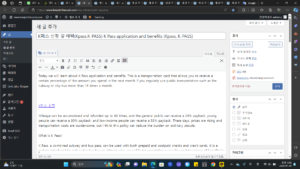Today we will learn about K Pass application and benefits.This is a transportation card that allows you to receive a certain percentage of the amount you spend in the next month if you regularly use public transportation such as the subway or city bus more than 15 times a month.K패스 신청

Mileage can be accumulated and refunded up to 60 times, and the general public can receive a 20% payback, young people can receive a 30% payback, and low-income people can receive a 53% payback. These days, prices are rising and transportation costs are burdensome, but I think this policy can reduce the burden on ordinary people.
What is K Pass?
K Pass, a combined subway and bus pass, can be used with both prepaid and postpaid checks and credit cards. It is a system introduced to reduce the burden on citizens who use public transportation every day, and the range of benefits is truly wide as you can receive an additional 10% discount from credit card companies.
These points can also be used to exchange mobile gift certificates or recharge transportation cards. Let’s take a closer look at the refund amount for public transportation and the differences and benefits between Kpass and existing economical transportation cards.
Differences from economical transportation cards
While the economical transportation card offered a discount compared to the distance traveled, this K-Pass allows you to receive payback regardless of the distance traveled.
How to apply for K Pass
If you are a budget transportation card user, you can use the K Pass right away without going through the membership conversion process and having the card reissued. Starting in May 24, new users can apply for the K Pass transportation card through the official K-Pass website or mobile app starting in May 2024. It is available.
👇 Go to app download (Android)
👇Go to app download (iPhone)
K Pass Benefits
K Pass, a subway and bus integrated pass, provides a refund of up to 216,000 won per year within the support limit by accumulating 20 to 53% of the transportation amount up to 60 times when using public transportation such as the subway or bus more than 21 times a month. Young people can receive a refund of up to 324,000 won per year, and low-income people can receive a refund of up to 576,000 won per year.
▶ General: Accumulation rate 20%
▶ Youth (19-34 years old): Savings rate 30%
▶ Low-income (beneficiary and second-lowest class): 53.3% accumulation rate. K Pass must be used at least 21 times a month, regardless of distance traveled or amount spent, to receive a refund.
In the case of the previously refundable economical transportation card, many people pointed out that it was difficult to meet requirements such as insurance and bicycle travel distance and that the mileage payment structure was complicated, making it inconvenient for the elderly to use, so use was very low, so a new method was introduced to support transportation fee discounts. I decided to do it. Even if the business is converted from the economical transportation card to Kpass, existing economical transportation card users can use Kpass.
With the Kpass subway and bus integrated pass, if you use public transportation more than 21 times a month, you will receive a 20% discount on fares up to 60 times. Based on the basic Seoul city bus fare of 1,500 won, you will receive a 300 won discount once a month.
Currently, there are 13 economic transportation card partners, including Kookmin, Hyundai, Shinhan, Samsung, Hana, Nonghyup, BC Card, T-Money, K Bank, and Gwangju Bank.
Public transportation fares in Seoul and nationwide
Based on a general card, the price for city buses has been increased to 1,500 won for main/local lines, 1,200 won for village buses, 3,000 won for metropolitan areas, 1,400 won for circular/differential buses, and 2,500 won for late-night buses.
The price for village buses, main lines, green buses, circular buses, and graded buses has increased by 300 won, metropolitan buses have increased by 700 won, and late-night buses have increased by 350 won. The rates for teenagers and children, which had been frozen for 16 years, were also adjusted to about 60% of the regular rate for teenagers and about 37% for children.
finish
Today, we learned all about how to apply for the K Pass and the differences between it and the economical transportation card. Looking at the recent rollout of policies such as K-Pass and Climate Companion Card, we can see that the government is making many efforts to greatly reduce the burden of subway fares on citizens.
Good article to read together
Summary of how to apply and use the Seoul Climate Companion Card
Travellog Card (Credit vs. Check)
How to use the Travel Wallet card (issuance, advantages, withdrawal)
Learn how to use Kakao Taxi
Summary of Busan Dongbaek Pass application and discount benefits
2024 Youth Leap Account conditions and application method